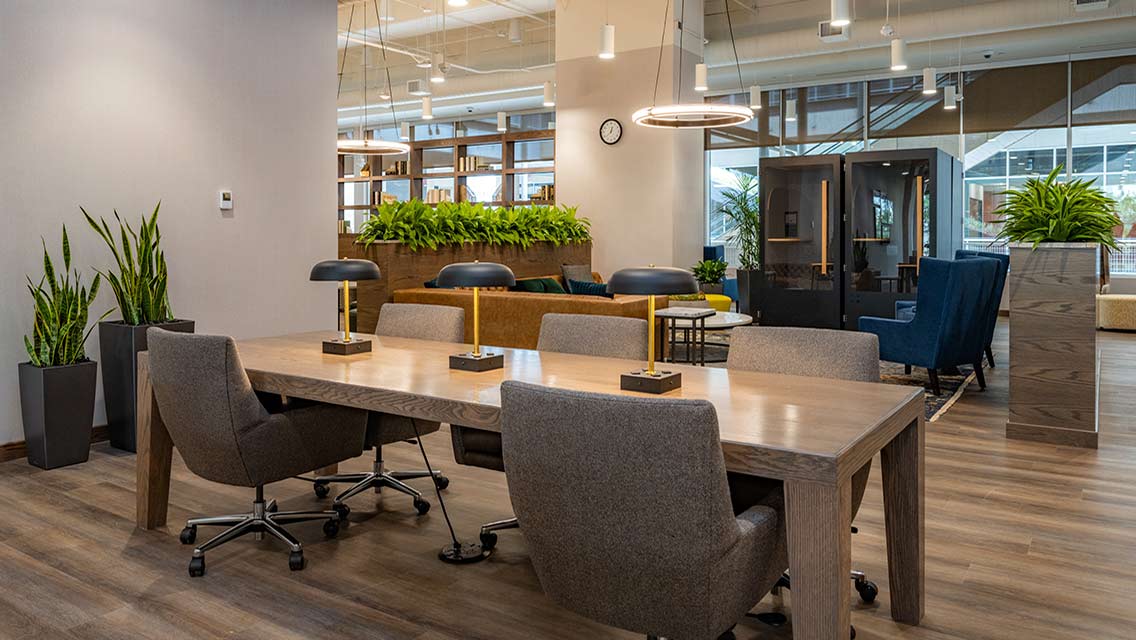If you’ve worked a white-collar job during the last year-and-a-half of the pandemic, you probably know, or at least sense, that there is a revolution developing in the way this kind of work is conceived, managed, and carried out. While millions of essential workers, including farm laborers, food-service employees, and first responders, have been doing their hard tasks onsite, those of us for whom the computer is the anchor of our workday have been taking part in an unprecedented experiment: remote work on a massive scale.
As this article is being written, we are in a very uncertain transition period. For some people, the pandemic is receding as a daily reality, even as it surges thanks to a deadly new variant. Our heroic healthcare workers are still in battle mode. But white-collar employers and employees are preparing for a post-pandemic future. That future, say many experts, will almost certainly be hybrid. That is, an as-yet-unclear mix of “back to the office” and “working at home.”
The remote-working experience changed the dynamics of work, as well as the attitudes toward work, for many. According to a May 2021 Gallup survey, the percentage of U.S. white-collar employees working remotely was 72 percent, roughly the same percentage as at the pandemic’s height in 2020. A Best Practice Institute poll of more than 3,300 employees taken in 2021 indicated that no less than 90 percent of respondents either don’t want to return to the office at all or prefer a hybrid setup. And Harvard Business School researchers found that 61 percent of their survey respondents, all professionals, would prefer to work remotely two or three days a week, while 27 percent voted for full-time remote work.
Anecdotal evidence suggests that safety concerns — people’s unwillingness to return to enclosed spaces full of other people, for example — play a major role in these preferences. Other factors include the desire to remain closer to family; the need for more control of their own time; freedom from the commuter grind; money saved on gas, tolls, wardrobe, and more; more time to spend on fitness regimens and other healthy pursuits — the list goes on. And here’s another statistic: A Microsoft-led global study revealed that 41 percent of workers are considering leaving their jobs in 2021.
So accommodating workers’ needs and preferences — including a preference for something other than 9-to-5 in the cubicle — makes sense.
“I believe that we are still in the process of figuring this out as a society,” says Tracy Brower, a PhD sociologist and author who specializes in workplace issues. “There are so many companies who never saw remote work or hybrid work as a possibility and now they’re in a whole new mind-space about it.”
Some enterprises are leading the charge, including the work-organizing company Slack and online seller Square, which at this writing are sticking with a mostly remote workforce. Twitter, which instituted generous remote-work policies before the pandemic, has told workers that they can work from home “forever,” while Spotify has offered the same terms to most of its employees. Giants Google, Amazon, and Microsoft, on the other hand, are largely committed to the hybrid model, allowing most employees to split their time between office and offsite.
In May 2021 Google boss Sundar Pichai announced a hybrid workweek, in which the majority of workers are allowed to spend three days in the office and two days working offsite. (The company is also allowing some workers to request a change of office locations altogether and some to work remotely full-time.)
“Our campuses have been at the heart of our Google community and the majority of our employees still want to be on campus some of the time,” he said in the announcement. “Yet many of us would also enjoy the flexibility of working from home a couple days [a] week, spending time in another city for part of the year, or even moving there permanently.”
Women, OPEC, and ROWE
The pandemic and its effects may be the most obvious driver of the movement toward hybridity and flexibility right now, but the push for a more flexible workplace is actually about six decades old. It was first sparked by the influx of women into the work force beginning in the 1960s. Businesses found themselves under increased pressure to accommodate the individual needs of mothers. At the same time, academic researchers began studying the impact of changing family structures on business and industry — as well as the effect of work structures on families and individuals. Other factors contributed too, including the 1973 OPEC oil embargo and subsequent spikes in gas prices, which made the daily commute more expensive.
It soon became clear to researchers that the way work is designed in time and space is really an artifact of the mid-1930s. Policies from this period — when factory-based industrial jobs demanded onsite presence and single-wage-earner families were the norm — were failing to keep up with the changing needs of business and working families.
And there were the mental and emotional health issues. A 2002 Families and Work Institute study reported that well over half of all respondents felt like they didn’t have enough time for themselves or their families. The resulting stress made many feel that they couldn’t operate at their personal or professional best.
Research connected this sort of frustration and stress with some of the most serious health problems we face. A seminal 1999 report from the National Institute for Occupational Safety and Health, a unit of the U.S. Department of Health and Human Services, summarized 20 years of studies on the relationship between job stress and ill health, concluding that job stress was a significant contributor to cardiovascular disease, musculoskeletal problems, and psychological disorders.
By the early 21st century, the demand for flexibility was coming from all quarters: older workers, many of whom wanted to work past retirement age without being locked into the old paradigm; middle-agers caring for elderly parents; and Gen X and Y workers, for whom balance between personal life and work was practically a nonnegotiable demand.
Some organizations and employers who were aware of the issues developed schemes to accommodate workers: flextime (adjustable start and end times on a full-time schedule), compressed scheduling (often five days’ work in four), job sharing, guaranteed time off for personal needs, phased retirement, and part-year work.
Working From Home
But the most consequential form of flexibility was telecommuting, or working from home, which turns out to have been prophetic of the pandemic-driven remote-working recent past and the likely hybrid future. “Those policies,” writes Harvard Business School’s Prithwiraj Choudhury, “allowed people to eschew physical offices in favor of their homes, coworking spaces, or other community locations, such as coffee shops and public libraries, for occasional days, on a regular part-time basis, or full-time, with the expectation that they would come into the office periodically.”
One of the most radical versions of what Choudhury is talking about was Results-Only Work Environment (ROWE), a scheme pioneered in 2003 by two employees of Best Buy, Jody Thompson and Cali Ressler. In ROWE, office attendance was entirely optional and employees were responsible only for delivering agreed-upon results at agreed-upon times. Adopted with considerable success by Best Buy itself, it languished and was canceled in 2013 by newly hired CEO Hubert Joly. In a New Yorker essay comparing the plan with today’s hybrid concepts, work-and-technology expert Cal Newport argues that the idea faded away because Best Buy failed to integrate the scheme into training for new hires and thus into its corporate culture as a whole.
Third Places
As Choudhury notes, the work-at-home shift was never about the simple choice between home or office; “third places” like coffee shops were part of it from early on, and the rise of coworking spaces represents yet another “third space” alternative.
James O’Reilly, president of Life Time Work, a coworking venture that Life Time launched in 2018, points out that while coworking spaces started out mainly as incubators for small tech startups, today they are part of flexibility and hybridity plans for many established companies — and he offers Life Time Work’s clientele as a case in point. “Our spaces,” he says, “are really for established professionals. We have a number of startups, but it’s a small percentage of our total membership. We’re predominantly serving companies that have been around for five to 15 years.”
O’Reilly believes that we are moving into an economy in which employees have much greater power to set the terms of where and how they work, and that this will drive the growth of flexible policies. “During the pandemic we saw that we can be more productive working from other places than the primary office,” he says. “But we also saw that working from home has its inherent challenges, whether it’s chasing the kids, chasing dust bunnies around the house, or trying to avoid the fridge or the bed during the workday. I think coworking spaces come in there — in particular those coworking spaces that situate themselves in close proximity to where people live.”
Being Flexible About Flexibility
Tracy Brower acknowledges the appeal of remote work, whether at home or in a third place, but she also notes that a face-to-face work environment nurtures collaboration, networking, learning, and the sharing of intangibles like corporate culture. And she emphasizes that the hybrid model that’s emerging isn’t just an organizational challenge — who will work where, and when — but a call for companies to clarify processes and principles.
“Corporate cultures,” she says, “are most successful when people talk really openly about their values and the way they do business and what their processes are, particularly when it comes to the new hybrid work environment. If we’re a team, we need to talk openly about when we need everybody in the office. We need to talk openly about when hybrid works and when it doesn’t. Let’s face it, sometimes it’s easier when everybody is on a screen, and other times it’s better when everybody’s in person.”
Brower calls this being “flexible about flexibility.” Hybrid work, she says, “is very complex, and a major landmine is to oversimplify it and to believe that leaders can make one decision — ‘We’ll go hybrid’ — and everything will fall into place.” (Best Buy’s failure to institutionalize ROWE comes to mind.)
Ultimately, though, she believes that the effects of the pandemic and going remote have gone deeper than simply foregrounding new forms and structures for white-collar work. “I think it has taught us that we can trust people and that they will perform,” she says, “if they have the tools they need and are supported. It’s made us think consciously about work, about our work process, about our workplaces, about our work colleagues. It’s made us think consciously about our priorities, as all the little stuff gets stripped away and we figure out what’s really critical.
“It’s revealed how critical the well-being of workers is, and how important it is to treat them holistically. People are simply going to be able to work better if we pay attention to their well-being, serve them as a whole person, so they can bring their whole selves to work.”





This Post Has 0 Comments